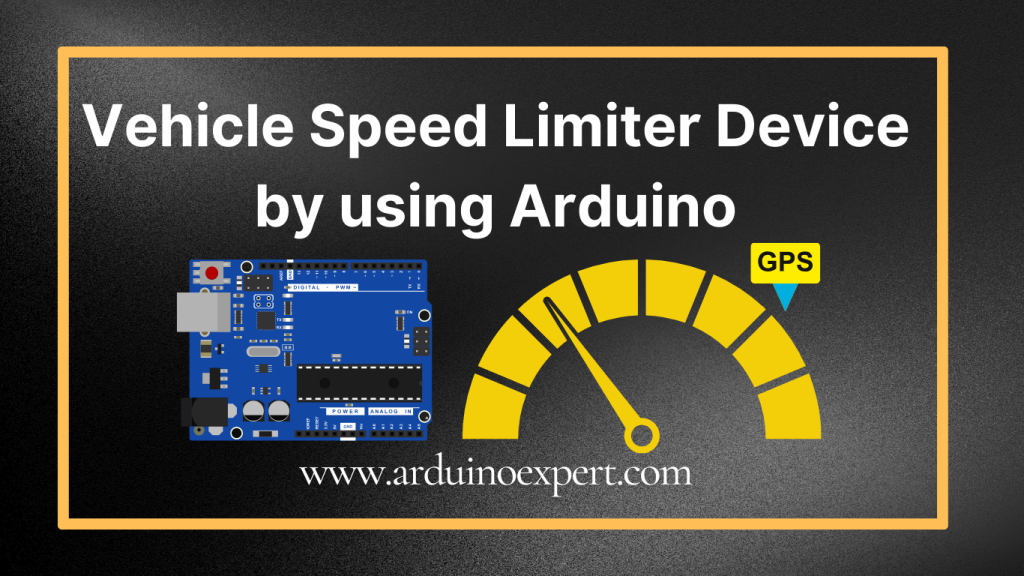The Vehicle Speed Limiter Device is an innovative system designed to enhance road safety by monitoring and controlling a vehicle’s speed in real-time. Leveraging the power of Arduino, GPS, GSM modules, and a buzzer, this device provides an integrated solution for enforcing speed limits. The system not only alerts drivers when they exceed the speed limit but also sends notifications to remote users and can automatically limit the vehicle’s speed if necessary. By incorporating the Blynk IoT app, the project extends its functionality to include remote monitoring and control, making it ideal for various applications, from personal vehicles to commercial fleets.
In today’s world, speed regulation is crucial due to the increasing number of road accidents caused by over-speeding. The traditional methods of speed monitoring, such as manual checks and speed cameras, have their limitations. This project addresses these limitations by providing a real-time, automated solution that actively involves the driver, remote supervisors, and the vehicle itself. With the ability to set and adjust speed limits remotely, receive alerts, and take immediate action when necessary, this device serves as a powerful tool for enhancing road safety and ensuring compliance with speed regulations.

Components Used in the Project:
Arduino Board (Arduino Uno)
The central microcontroller unit for processing data and controlling peripherals.
GPS Module (NEO-6M)
Used to determine the vehicle’s current speed by receiving signals from GPS satellites.
GSM Module (SIM900A)
Sends SMS alerts when the speed limit is exceeded and allows for remote communication.
Blynk IoT App
A mobile app for real-time monitoring and control of the device.
Buzzer Alerts
the driver with an audible alarm when the vehicle exceeds the speed limit.
Power Supply (e.g., 12V battery)
Provides power to the Arduino and other components.
Miscellaneous Components
- Connecting Wires
- Breadboard (for prototyping)
- Resistors, Capacitors, etc., as needed for the specific modules used.
Working of Project:
1. GPS Module Integration
- The GPS module continuously receives data from satellites, which includes the vehicle’s current speed and location.
- The GPS module transmits this data to the Arduino, which then processes the speed information.
2. Arduino Microcontroller
- The Arduino acts as the brain of the system. It processes the speed data from the GPS module.
- If the vehicle’s speed exceeds the predefined limit, the Arduino triggers an alert and sends a signal to the relay module.
- The Arduino also communicates with the GSM module to send alerts via SMS and with the Blynk server for real-time monitoring.
3. GSM Module for Communication
- The GSM module is used to send SMS alerts to a predefined phone number if the speed limit is breached.
- It can also receive commands via SMS, such as adjusting the speed limit remotely.
4. Buzzer for Alarm
- The buzzer provides an immediate audible warning to the driver when the vehicle exceeds the speed limit, encouraging them to reduce speed.
5. Blynk IoT App for Monitoring and Control
- The Blynk app allows users to monitor the vehicle’s speed in real-time.
- Users can remotely set or adjust the speed limit via the app.
- The app can also send notifications if the vehicle exceeds the speed limit.
6. Speed Limiter Mechanism
- When the vehicle exceeds the speed limit, the Arduino triggers the relay module, which activates the speed limiter.
- The speed limiter could either cut off the fuel supply, reduce throttle input, or engage any other mechanism that limits the vehicle’s speed.
Circuit Diagram:

Code:
#include <TinyGPS++.h>
#include <SoftwareSerial.h>
#define SerialAT Serial1
#define BLYNK_PRINT Serial
#define TINY_GSM_MODEM_SIM808
#include <TinyGsmClient.h>
#include <BlynkSimpleTinyGSM.h>
#define BLYNK_TEMPLATE_ID "TMPLLADwvoei"
#define BLYNK_TEMPLATE_NAME "Speed Limit Device"
#define BLYNK_AUTH_TOKEN "WpPAnsuVauQ_aEmJbTlNwIbF_95_Pwd-"
char apn[] = "DU";
char user[] = "";
char pass[] = "";
TinyGsm modem(SerialAT);
//------------------Initialization of all variables--------------------------------
int Speed = 0, Last_Speed;
double lat = 24.346694;
double lon = 54.559146;
BlynkTimer timer;
#define gpsSerial Serial2
int Buzzer_Pin = 4;
int count = 0;
int GPSBaud = 9600;
bool flag = false, flag2 = true, flag3 = true;
unsigned long pms, cms, pms2 = 0;
int control = 8;
int BONT = 1000, BOFFT = 3000; // Buzzer ON time and Buzzer Off time in milli seconds
int DBT = 10000; // Delay time between 2 tickets in milli seconds
// Create a TinyGPS++ object
TinyGPSPlus gps;
#include <SoftwareSerial.h>
SoftwareSerial mySerial(7, 8); //Rx Tx
char msg;
char call;Testing:
Testing and Implementation
- Initial Setup
- Power up the system and ensure all connections are secure.
- Upload the Arduino code and ensure that the GPS, GSM modules, and buzzer are functioning correctly.
- Real-time Monitoring
- Use the Blynk app to monitor the vehicle’s speed in real-time.
- Test the notifications and ensure you receive an alert when the speed limit is breached.
- Driver Alert Mechanism
- Drive the vehicle at different speeds to test the activation of the buzzer. Ensure the buzzer activates when the speed exceeds the limit and deactivates when the speed is reduced.
- Speed Limiting Mechanism
- Test the relay or speed limiting mechanism to ensure it functions as expected, reducing the vehicle’s speed when necessary.
Applications
1. Fleet Management
In commercial fleet operations, maintaining a consistent speed and adhering to speed limits is critical for safety, fuel efficiency, and compliance with regulations. The Vehicle Speed Limiter Device can be used in fleet management systems to ensure that drivers do not exceed speed limits. Fleet managers can remotely monitor vehicle speeds in real-time using the Blynk IoT app, receive alerts when limits are breached, and even set speed limits based on different regions or road conditions. This helps in reducing the risk of accidents, lowering fuel consumption, and minimizing wear and tear on vehicles.
2. School Buses and Public Transportation
Ensuring the safety of passengers, especially children, is a top priority for school buses and public transportation systems. The Vehicle Speed Limiter Device can be installed in these vehicles to monitor and enforce speed limits. The buzzer provides an immediate alert to the driver, ensuring they take corrective action, while remote monitoring through the Blynk app allows school administrators or transport authorities to keep track of all vehicles in the fleet. This system helps in preventing over-speeding in sensitive areas like school zones, residential areas, and busy city streets.
3. Personal Vehicles
For individual vehicle owners, especially those concerned with the driving habits of teenage drivers or elderly family members, this device offers peace of mind. By setting a speed limit and receiving notifications, parents or guardians can ensure that their loved ones are driving safely. The buzzer provides immediate feedback to the driver, making them aware of the speed limit breach, while the remote monitoring feature allows family members to track driving behavior and intervene if necessary.
4. Rental Car Services
Rental car companies can implement the Vehicle Speed Limiter Device to monitor the speed of their vehicles when rented out. This not only helps in ensuring that the vehicle is not driven recklessly but also aids in protecting the vehicle from potential damage due to over-speeding. Additionally, the ability to remotely monitor and set speed limits enhances customer service by allowing the company to provide safe driving limits based on the renter’s driving experience or the specific conditions of the rented vehicle.
5. Logistics and Delivery Services
In logistics and delivery services, timely and safe delivery of goods is paramount. The Vehicle Speed Limiter Device can be used to monitor and control the speed of delivery vehicles to ensure they operate within safe limits. This helps in avoiding accidents, reducing fuel costs, and ensuring that goods are delivered safely and on time. The system also enables companies to monitor driver behavior and take corrective action if necessary, thereby improving overall operational efficiency.
6. Government and Law Enforcement
Government agencies and law enforcement bodies can use this device in official vehicles to ensure compliance with speed regulations. The system can be particularly useful in areas with strict speed limits, such as construction zones, school zones, or residential areas. By providing real-time speed monitoring and the ability to set speed limits remotely, the device aids in enforcing traffic laws and ensuring the safety of both officers and the public.
7. Insurance Monitoring
Insurance companies can offer lower premiums to customers who install the Vehicle Speed Limiter Device in their vehicles. By ensuring that the vehicle is driven within safe speed limits, the risk of accidents is reduced, leading to fewer claims. The device can also provide data on driving behavior, which can be used by insurance companies to assess risk more accurately and reward safe drivers with better rates.
Conclusion:
The Vehicle Speed Limiter Device, with its ability to monitor, alert, and control vehicle speed, has wide-ranging applications across various sectors. Its integration with the Blynk IoT app enhances its functionality, making it a versatile tool for both personal and commercial use. By promoting safe driving practices, reducing the risk of accidents, and ensuring compliance with speed regulations, this project contributes significantly to road safety and operational efficiency in multiple industries.



